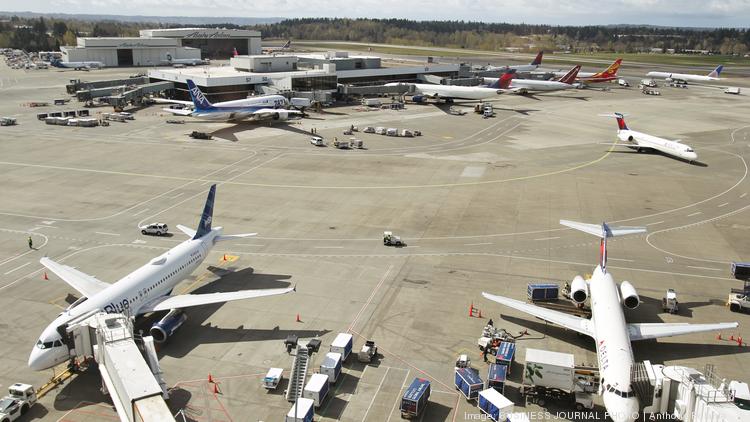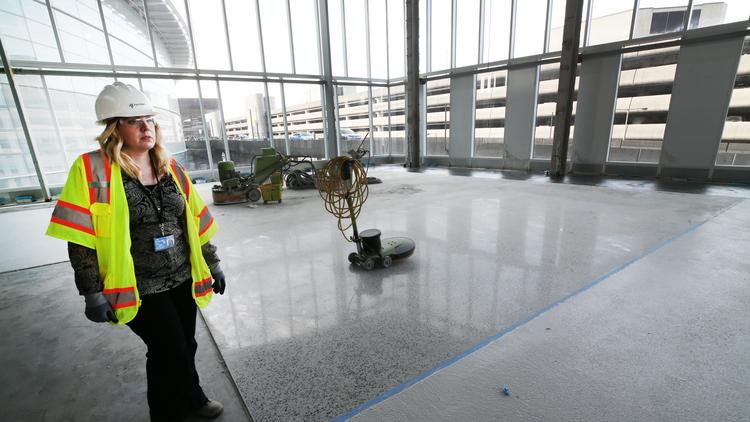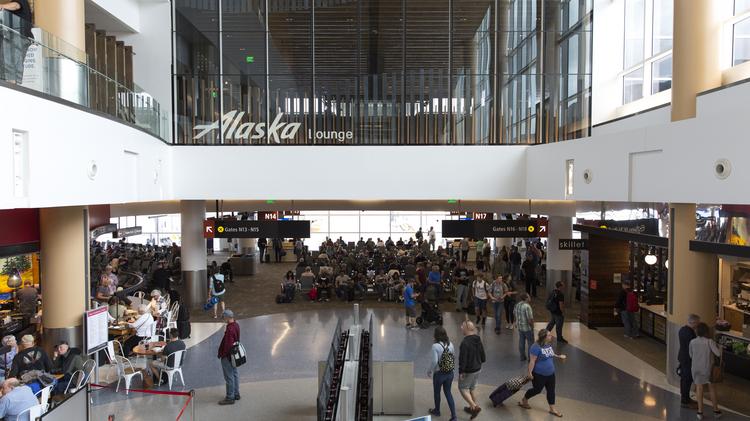
Sea-Tac Airport passenger volumes are surging, hitting 51.8 million in 2019 and forecast to hit 56 million a year by 2027. Airport staffers are planning projects now to be finished or underway by then to ensure the facility can handle the growth.
By Andrew McIntosh Reporter, Puget Sound Business Journal
Trying to forecast what an airport will need 20 years in the future to best serve airlines and passengers is tricky business, but that’s the challenging job of airport planners.
Two Seattle-Tacoma International Airport staffers involved in crafting the latest master plan for the Puget Sound region’s future needs — they call it the Sustainable Airport Master Plan (SAMP) — explained their work.
“This airport master plan is not what we aim for, it’s what we expect is coming,” explained Clare Gallagher, a Port of Seattle director of capital projects delivery. “Expanding Sea-Tac is not like building a greenfield airport, we are very constrained. We only have approximately 2,600 acres of property on and around the airport, and of that, just 1,900 acres are able to accommodate existing and future airport operational uses.”
Airport operations are regulated by the Federal Aviation Administration and airports must typically update their master plans every decade or so.

Port of Seattle Aviation Project Management Group Capital Construction Project Manager Janet Sheerer stands near the new facilities of U.S. Border Patrol and Customs inside the future International Arrivals Facility, which is scheduled to open in the fall.
Often, the need for a new master plan is triggered if airlines have significantly changed operating practices since their most recent plan was completed, or the airport is anticipating the need to significantly expand facilities in the near future due to strained existing facilities and anticipated growth.
In Sea-Tac’s case, efforts to produce the updated master plan began in late 2014. This was after construction began on the current expansion, including the International Arrivals Facility, as well as the North Satellite terminal expansion.
Alaska Airlines’ flagship lounge at Sea-Tac Airport

Alaska Airlines’ flagship Sea-Tac Airport lounge opened in July. The 15,800-foot rooftop facility offers views, brews and space you can use.
The latest plan has been controversial and faced searing criticism from both Alaska Airlines and former Washington Gov. Gary Locke.
It includes a new North terminal with 19 gates, and an expanded fuel area to make room for sustainable aviation biofuels.
There’s also an elevated bus guideway people mover with three stations to connect the new terminal with the rental car facility, and existing main terminal. Early estimates peg the projects’ total value at $2.3 billion.
Altogether, there are 30 near-term projects in the plan which aim to improve efficiency, safety, access to the airport, and offer new cargo and airport/airline support facilities, like aircraft maintenance buildings and fuel storage, as well as more parking.
Those projects will be complete or under construction by 2027, helping the airport meet forecasted demand of up to 56 million passengers, up from 51.8 million in 2019.
Tom Hooper, a Port of Seattle manager of aviation planning, said people in his world liken airport master plans and their various parts to a three-legged stool: The airfield is one leg, terminals and passenger processing buildings are the second, and land-side operations (roads, curbs and parking systems) the third.
“You need all three working to make an airport function properly,” Hooper said. “It’s not just aircraft and gates.”
Airport planners even have their own specialized computer tool, the “TAAM.”
That stands for Total Airspace and Airport Modeler, a specialty software application developed by Boeing affiliate Jeppesen that conducts simulations of their plans to study outcomes.
Airport master plans include many ingredients. Airlines are canvassed for their aircraft fleet plans and projected market growth. That’s stirred in with cost of travel factors like underlying socioeconomic conditions to develop a forecast of activity, and forecasts for resulting flight schedules to determine facility requirements for five, 10, 15 and 20 years ahead.
That’s added to gross domestic product projections, different airspace conditions and even the local weather to model for delays.
The result is the current Sea-Tac plan, which at high level, also involves moving some existing roadways and utilities to increase airfield areas to accommodate more airplanes.
“We did a lot of robust analysis to determine that 19 new gates are needed,” Gallagher said. “It’s the best we think we can do on this footprint. Though we have confidence in the planning, there is still more analysis to be done through the environmental review before the projects can be approved for construction.”
The airport officials explained that when environmental reviews are completed — that process has been delayed until 2021 – each one of the 30 near-term master plan projects will be presented to the five elected port commissioners, who will review and discuss their merits before either voting to approve, modify or reject each one.